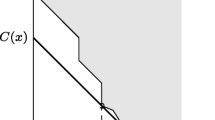Abstract
Kolmogorov complexity measures the amount of information in a string as the size of the shortest program that computes the string. The Kolmogorov structure function divides the smallest program producing a string in two parts: the useful information present in the string, called sophistication if based on total functions, and the remaining accidental information. We formalize a connection between sophistication (due to Koppel) and a variation of computational depth (intuitively the useful or nonrandom information in a string), prove the existence of strings with maximum sophistication and show that they are the deepest of all strings.
Similar content being viewed by others
References
Antunes, L., Fortnow, L., van Melkebeek, D., Vinodchandran, N.: Computational depth: Concept and applications. Theor. Comput. Sci. 354(3), 391–404 (2006)
Bennett, C.H.: Logical depth and physical complexity. In: Herken, R. (ed.) The Universal Turing Machine: A Half-Century Survey, pp. 227–257. Oxford University Press, London (1988)
Chaitin, G.: On the length of programs for computing finite binary sequences. J. ACM 13(4), 145–149 (1966)
Cover, T.M.: Kolmogorov complexity, data compression, and inference. In: Skwirzynski, J.K. (ed.) The Impact of Processing Techniques on Communications, pp. 23–33. Nijhoff, Dordrecht (1985)
Daley, R.: Busy beaver sets: characterizations and applications. Inf. Control 52, 52–67 (1982)
Gács, P., Tromp, J., Vitányi, P.: Algorithmic statistics. IEEE Trans. Inf. Theory 47(6), 2443–2463 (2001)
Kolmogorov, A.N.: Three approaches to the quantitative definition of information. Probl. Inf. Transm. 1(1), 1–7 (1965)
Koppel, M.: Structure. In: Herken, R. (ed.) The Universal Turing Machine: A Half-Century Survey, pp. 435–452. Oxford University Press, London (1988)
Koppel, M.: Learning to predict non-deterministically generated strings. Mach. Learn. 7, 85–99 (1991)
Koppel, M., Atlan, H.: An almost machine-independent theory of program-length complexity, sophistication, and induction. Inf. Sci. 56, 23–33 (1991)
Levin, L.: Universal search problems. Probl. Inf. Transm. 9, 265–266 (1973)
Li, M., Vitányi, P.: An Introduction to Kolmogorov Complexity and its Applications, 2nd edn. Springer, Berlin (1997)
Shen, A.: The concept of (α,β)-stochasticity in the Kolmogorov sense, and its properties. Sov. Math. Dokl. 28, 295–299 (1983)
Solomonoff, R.: A formal theory of inductive inference, part I. Inf. Control 7(1), 1–22 (1964)
Vereshchagin, N., Vitányi, P.: Kolmogorov’s structure functions and an application to the foundations of model selection. In: Proc. 47th IEEE Symp. Found. Comput. Sci. (2002)
Vitányi, P.: Meaningful information. IEEE Trans. Inf. Theory 52(10), 4617–4627 (2006)
V’yugin, V.V.: Algorithmic complexity and stochastic properties of finite binary sequences. Comput. J. 42(4), 294–317 (1999)
Author information
Authors and Affiliations
Corresponding author
Additional information
Preliminary version of this paper appeared in the Proceedings of the 30th ICALP Conference (Lecture Notes in Computer Science, vol. 2719, pp. 267–277. Springer, Berlin, 2003). Much of the research for this paper occurred at the NEC Research Institute. Luís Antunes is partially supported by KCrypt (POSC/EIA/60819/2004) and funds granted to LIACC through the Programa de Financiamento Plurianual, Fundação para a Ciência e Tecnologia and Programa POSI.
Rights and permissions
About this article
Cite this article
Antunes, L., Fortnow, L. Sophistication Revisited. Theory Comput Syst 45, 150–161 (2009). https://doi.org/10.1007/s00224-007-9095-5
Received:
Accepted:
Published:
Issue Date:
DOI: https://doi.org/10.1007/s00224-007-9095-5




